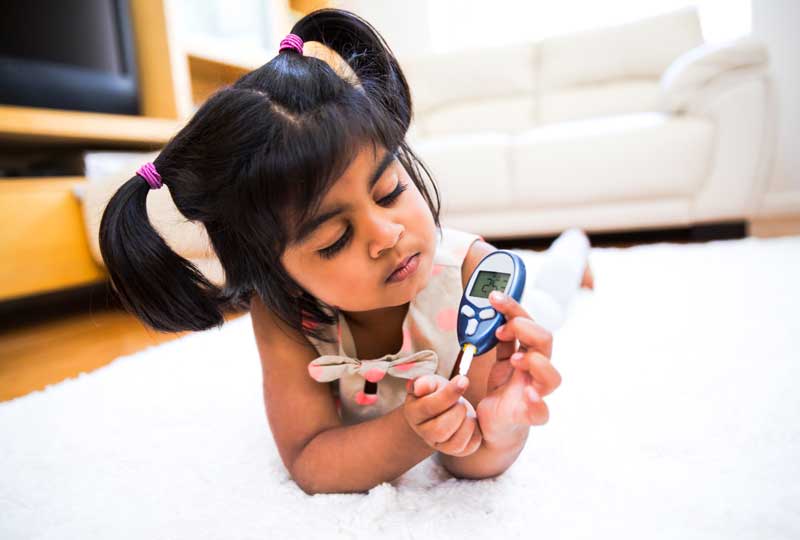Get the facts on both types of diabetes, and how each affects children.
All humans have sugar in their blood. It fuels the organs in our bodies and gives us energy. While we all need some sugar in our blood — also known as blood glucose — our bodies produce the hormone insulin. Insulin keeps the amount of glucose in our blood within a certain range.
When a person’s body loses the ability to regulate blood glucose on its own, however, that person likely has diabetes. There are many categories of diabetes — such as type 1 diabetes and type 2 diabetes — and each one is slightly different.
Here we break down type 1 and type 2 diabetes, and how each affects children.
Type 1 diabetes
“We have a lot of really good treatments and technology that make checking blood sugar and giving insulin a little bit easier and straightforward for families, and we know that if you give insulin and you can control those blood sugars, you can prevent complications from diabetes.”
Type 1 diabetes is a chronic autoimmune disease, and it’s the most common form of diabetes in children. In patients who have type 1 diabetes, “the body’s own immune system recognizes the cells in the pancreas that make insulin as bad things, and it attacks and destroys those cells,” said Dr. Jennifer Kelley, an endocrinologist with the Diabetes Program at Monroe Carell Jr. Children’s Hospital at Vanderbilt.
“Insulin is what keeps the sugar in the blood in a normal range,” Kelley explained. “Without insulin, sugar cannot get into the brain and the muscles and the organs of the body for energy — instead, sugar stays in the blood and goes high.”
Although doctors aren’t entirely sure what causes type 1 diabetes, “there are likely several components involved, including genetic and environmental factors,” Kelley said. But “it is nothing that the patient or the family did to cause it.”
Kelley also said that despite what most people think, type 1 diabetes is not caused by eating too much sugar. Regardless, being diagnosed with type 1 diabetes means that your body is no longer able to make its own insulin, which means you require insulin immediately and it becomes a lifelong requirement.
Although there is no cure, “we have come a long way in diabetes treatment,” Kelley explained. “We have a lot of really good treatments and technology that make checking blood sugar and giving insulin a little bit easier and straightforward for families, and we know that if you give insulin and you can control those blood sugars, you can prevent complications from diabetes.”
Type 2 diabetes
The main problem caused by type 2 diabetes, on the other hand, is that the body has a harder time responding to insulin.
“Your pancreas may still make insulin, but you may be resistant to it — and that’s called insulin resistance,” Kelley said. “That can result in not being able to control blood sugars and lead to type 2 diabetes.” In addition, your body may just not be able to make enough insulin to overcome this resistance.
Like type 1, there can be many different causes for type 2, Kelley explained.
“We know that the rising rate of obesity in kids is associated with higher rates of type 2, so we know that obesity is a risk factor — but it’s also not as simple as, for example, eating too many pieces of candy either,” she said. “We also see increased risk of type 2 diabetes if there’s a family history of type 2 diabetes, so there does seem to be a genetic component as well.”
In terms of treating type 2 diabetes, some individuals might require insulin, but there are also other medications that can be used for treatment. In addition to medications, “some dietary and lifestyle changes, working with a dietitian to reduce the intake of added sugar or processed carbohydrates in the diet and also increased physical activity” can help improve type 2 diabetes, Kelley said.
How diabetes affects children
Diabetes as a whole — both type 1 and type 2 — is different in kids than adults, Kelley explained.
“We know that the presentation of diabetes as well as the severity and the course of the diabetes are all a little bit different in kids,” she said. That’s why it’s imperative to get diabetes under control as early as possible.
In other words, “if you let blood sugar stay high and don’t control it, over time the high blood sugars can start to damage the blood vessels and nerves that go to parts of the body like the eyes, the kidneys and/or your extremities, just as an example,” Kelley said. “Eventually, it can cause you to have problems with all those organs, like loss of good blood circulation, nerve damage, etc.”
That can then cause permanent damage and result in loss of vision, kidney failure, increased risk for infections, etc. “It can also increase the risk for cardiovascular disease, which increases the risk for things like heart attacks or heart disease later in life,” she said.
“But the whole point is, if we control blood sugars, those things can be prevented,” Kelley added.

The Diabetes Program at Monroe Carell Jr. Children’s Hospital at Vanderbilt is one of the largest pediatric diabetes centers in the nation. These experts provide a family-centered approach to managing diabetes for more than 3,000 children from Tennessee and eight surrounding states. Our team cares for children in clinics throughout Middle Tennessee.




